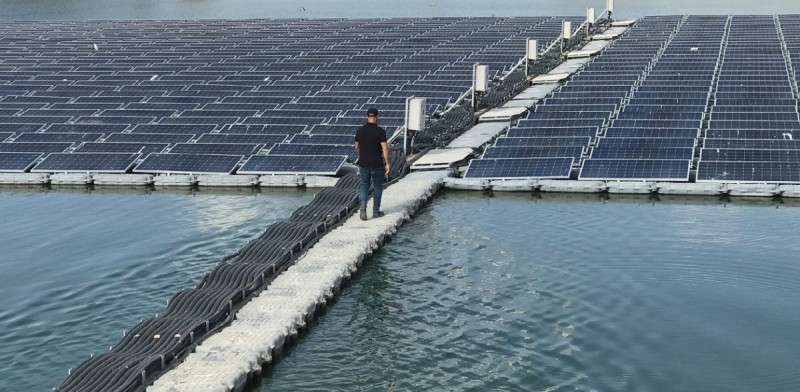Israel’s scarce land resources and lack of interconnections to neighboring countries have driven the rise of rooftop solar mounting. Now a number of recent policy changes, mainly due to electricity reforms, are set to reinforce the decentralization trend, reports Ilias Tsagas.

Image: pv magazine/Ilias Tsagas
The opportunities for Floating PV Solar Mounting are rising in Israel, as irrigation plays a big role in its agricultural sector.
Israel’s solar sector started in earnest in 2008 with the introduction of a feed-in tariff (FIT). Since then the country has embarked on several policy changes concerning the allocation and remuneration of PV. The nation runs regular tenders for utility scale solar and the rooftop segment is also catching the eye.
Israel is a small nation with land-shortage issues, but developers seeking ground-mounted solar system project opportunities are also handicapped by the fact that most of the population is concentrated in a central belt, where prices are very high. While the government is investing in ambitious plans for agrivoltaics, agricultural and commercial activity further restricts the number of solar sites available.
Despite the lack of space, Israel has a goal of generating 30% of its electricity from renewables by 2030. And given that wind power is limited, that largely means solar. With policymakers, industry associations, and business agreeing on the need for dual-use deployment, rooftop solar mounting offers a neat solution as part of the puzzle.
Whereas other nations have phased out fixed payments for solar, Israel’s rooftop FIT remains. The FIT payments have a duration of 25 years and are currently the main force supporting Israel’s rooftop PV segment. Last year, rooftop arrays with a generation capacity of up to 200 kW (AC) qualified for FITs. This year that rule changed to permit only systems up to 100 kW to bank the €0.12 ($0.12)/kWh payment, although owners of systems up to 300 kW can still receive a reduced tariff. Those sky-high property prices in the central belt also prompted a recent move to offer an additional, top-up payment of €0.014/kWh for sub-100 kW systems in such locations.
The current embrace of FITs was not always the case. In fact, the government had previously halted the FIT scheme, replacing it with a net metering program that ran from 2013 to 2018. But the government has now scrapped the net-metering program, re-introducing FITs. During its rollout, the net-metering program drove around 380 MW of largely rooftop generation capacity – although floating solar plants and at least one big ground-mounted solar system operated under the payment regime.
Nir Zohar, sales director at Israeli solar module cleaning company RST CleanTech, says the net metering system was attractive for factories and energy users with similar consumption profiles and high bills. For everyone else, Zohar says, FITs are better.
With the nation undergoing electricity sector reform since 2018, the popular net metering scheme fell out of favor because it was seen as distorting the market, explains Eitan Parnass, founder and director of Israel’s Green Energy Association. As part of the reforms, large electricity users will cease to pay a fixed price for power from Jan. 1, with big consumers paying higher evening prices when there is no solar energy generation.
Variable pricing will hit owners of net-metered sites who will receive lower tariffs when they are generating and have to pay more for power at other times. That could reduce income by up to 40% for such investors, says Parnass, who indicated the government is considering a compensation mechanism.
The lack of net-metering, though, has failed to stem rooftop installations, as RST CleanTech CEO Roy Sade explains. He previously worked for an Israeli PV developer and says municipalities were, and continue to be, big installers of rooftop solar, thanks to the FIT. Tel Aviv municipal government’s solar rooftops, for example, earn the city around $300,000 per month, says Sade.
It was working with municipalities that gave Sade the idea to start his panel cleaning company, after an enquiry from a high school where a student had slipped on water pooling in the yard – and claimed for injury – the result of an array being cleaned with a hose. The school asked about automated cleaning systems.
With panel makers stipulating warranty requirements, modules should not be cleaned during the day when they are hot and generating power, and with high-pressure cleaning is also prohibited, Sade came up with an automated cleaning system installed on the panels.
RST CleanTech began in 2011, with a pilot system on Sade’s roof. The technology was launched in 2013 and the business now cleans more than 2.5 million panels – 2 GW of generation capacity – worldwide. CleanTech has subsidiaries in Spain, Morocco, Brazil, Chile, and California, with plans for a presence in India.
The company cleans around half of Israel’s rooftop panels, it claims its cleaning solution increases the panels’ energy generation by up to 30% and also has a thriving floating-solar cleaning operation at reservoir sites.
Wastewater channeled into reservoirs met around two-thirds of the water needs of Israel’s agriculture last year and having panels over the bodies of water reduces evaporation. RST’s system often uses reservoir water to clean panels – at low pressure and at night – before returning the liquid back to the reservoir.
Apart from presenting a strong business case, Floating PV Solar Mounting on Israel’s water reservoirs is also thriving due to the country’s highly congested electricity grid. Reservoirs use electricity to pump water but most often there are no other electricity users near the reservoirs, hence the availability of grid space to connect floating solar, explains Sade.